The Top 6 Star Trek Science Mistakes
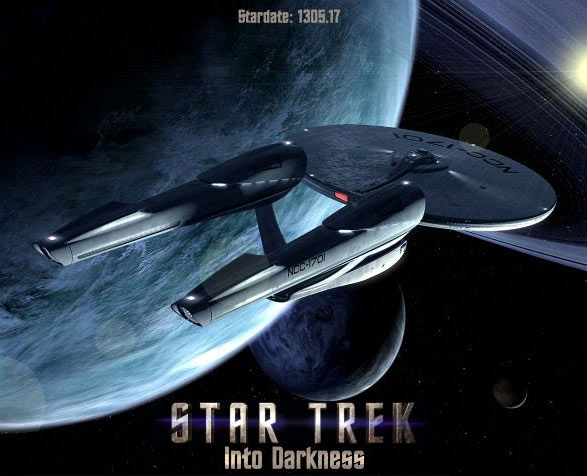
Photo by Paramount Pictures Corp. All rights reserved.
Today is the official U.S. premiere of the new movie, Star Trek Into Darkness, and yes, I’m excited. Maybe too excited. I’m a Galaxy-class Trek dork (here's plenty of proof of that), and have been since I was a little kid. I actually liked the 2009 reboot, mostly (see below), and liked all the series and movies to a certain degree (except Star Trek V: The Final Frontier, but c’mon, right?).
Still, as a scientist, I can’t help but notice that every now and again, just sometimes, maybe, Trek ventures into some pretty dicey science territory. Let me be clear: I have no problem with faster-than-light travel, time travel, teleporters, the Universal Translator, or anything like that. Every genre has a conceit, a gimme, and in scifi that means advanced tech that we can’t necessarily explain today. That’s fine, and as long as it’s internally consistent in the story I’m happy.
My beef is usually when the plot relies on some error in science, or when the tech is used inconsistently. If you discover, say, a Fountain of Youth in one episode, you’d better establish why everyone in the Federation isn’t young after that.
Say.
Anyway, what follows are some of my bigger science nitpicks for Trek. Again, I love the show, and I’m no Comic Book Guy (Worst. Character. EVER), so I don’t want you to think I sit around waiting for movies and TV shows to make errors so I can pounce on them with a fervor of supposed superior glee and vaporize them in a laser-focused burst of anal intellect.
I used to be that way, but I’m better now.
A little.
If it helps any, I once engaged (ha! See what I did there?) in a battle of Treknobabble with Wil Wheaton, who played Wesley Crusher on Next Generation. I lost, gloriously; he bested me when it came to dilithium crystals and warp drive. A humbled man, I have moved on to become more forgiving.
Well, except for what follows. Even a humbled man has limits. So shields up, and man your battlestations: We're on a collision course…with SCIENCE.
Voyager: Warped 10
In the later series like The Next Generation (usually called TNG) and Voyager, warp speed is exponential, with Warp 10 representing literally infinite speed. In an episode of Voyager, entitled “Threshold”, the crew discovers a way of going faster than Warp 10. I’m not exactly sure how you can travel faster than infinite speed, but let’s go with it for a moment.

Photo by Paramount Pictures Corp via Memory Alpha. All rights reserved.
Upon testing, a shuttle winds up being in every point in the Universe simultaneously, which, if you’re going literally infinitely fast, at least makes a kind of weird sense. However, the effects of this cause pilot Tom Paris to start mutating, growing and absorbing various organs, which understandably makes him a little nuts. So he decides to kidnap Captain Janeway—naturally—and steal a shuttle in the hopes of going Warp 10 again.
This time, both Janeway and Paris devolve into lizards, mate, have babies, get found by the Voyager crew, and then are bombarded by anti-protons to destroy the new mutated DNA and return them to their former selves.
I know. Look, I typed that last paragraph and even I have no clue what to do with it, so let’s just say that apparently Warp 10 is a state of infinitely bad science and just move on.
The Great Barrier Beef
In the second pilot episode of the original series (“Where No Man Has Gone Before”), the Enterprise encounters an energy barrier at the edge of the galaxy. Glowing pink and purple, it is said to be impenetrable, and in later episodes they say no form of transmission gets through it, either.
Here’s the thing: In real life, we see other galaxies outside our own. That means light can get through the barrier, but apparently in the 23rd century we’ve evolved beyond the need for light. Or something.
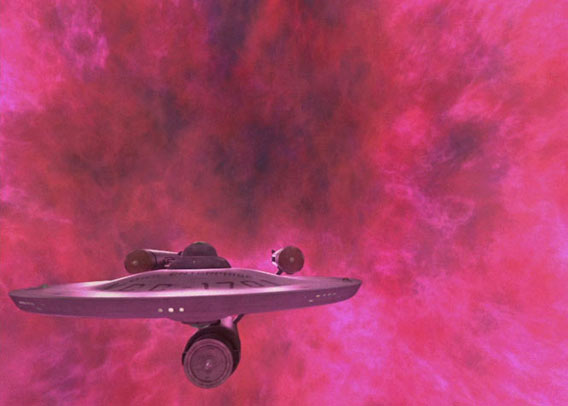
Photo by Paramount Pictures Corp via Memory Alpha. All rights reserved.
So I have a few problems with this. If the galaxy were enshrouded in a pink barrier, I think that would be obvious, even from Earth. After all, it would clash with the red giants. Also, as established in that episode, people with mild powers of ESP get them amplified hugely by the energy in the barrier, becoming essentially gods. Yet they cross the barrier a least one other time later in the series (“By Any Other Name”) with no ill effects. Maybe beforehand they cleared off all the crew who could do better than random chance predicting Zener cards.
And somehow, in Star Trek V, that became a barrier to the center of the galaxy, except it didn’t really exist, because God lived there, or an unreasonable facsimile thereof.
It suddenly occurs to me that people reading this who are not familiar with all the Trek shows and movies may be thinking I’ve lost my mind. That may or may not be the case, but never fear! We can fix my brain with transporter technology!
Fixing Things With Transporter Technology
The transporter was always a trusty piece of tech to either get someone out of a sticky situation, or to fail in such a way to put them into one. Many an episode relied on it in some way as a plot device. That’s fine, up to a point, but for some reason any actual advances made using it were forgotten by the time the credits roll.
In the TNG episode “Unnatural Selection”, Doctor Pulaski is infected with a disease that alters her DNA, rapidly aging her. She is about to die of old age when Captain Picard realizes they can use the transporter to cure her. They get a sample of her DNA from before she was infected, use it as a filter, and then fix her altered DNA.
It works (duh), with her instantly reverting back to her old young self after being beamed aboard.

Ignoring for the moment that she wouldn’t just transform back to being youthful—your current DNA isn’t a blueprint of the way you look right now (including hair style!)—there’s also the small problem that this transporter rejuvenation technique is a veritable Fountain of Youth. Just save a sample of your DNA from when you’re young—I’ll take the age of 25, please—and when you get old just step into a transporter, and poof! You’re young again.
Heck, you could even change your DNA! I’d like a little more hair, a touch redder, and a few centimeters added to my height, please. I rather like the way I am now, but I wouldn’t object to a few, um, modifications.
"Then they hurl heavy objects. And claw at you."
Speaking of DNA, this brings up a broader point about Trek: interspecies breeding (which, honestly, is an oxymoron). In the Trek universe alien races can interbreed (presumably, with a bit of technological help); Spock himself is a human-Vulcan hybrid. But that seems…unlikely. Think of it this way: We share 98 percent or so of our DNA with chimpanzees, yet cannot successfully breed with them. And we evolved on the same planet as chimps, with a common ancestor in our genetic lines just a few million years ago.
Even if you accept the idea from the TNG episode “The Chase”, where ancient aliens seeded planets throughout this quadrant with their own DNA—explaining why so many species are humanoids—over a few million years the drift in the genetic code would make humans and chimps seem like a couple made in OK Cupid heaven compared to even the most attractive of Vulcans. And even if you could somehow make it work, I think pon farr might make things a bit dodgy for the human involved. In vitro might be their best option anyway.
And don’t even get me started on sex with a Klingon. That’s a recipe for an ER visit at the very least.
It’s Just a Phase
OK, this one breaks my own rule about ignoring tech mistakes as long as it’s used consistently, but it bugs me.
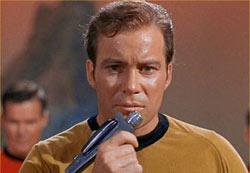
Photo by Paramount Pictures Corp. All rights reserved.
What happens to a person when they’re hit by a phaser set to “kill”?
In the show, they always glow and then they’re…gone. Poof. Disappeared.
But that makes no sense. If the phaser is a high-energy weapon (which they mention a few times in TNG) then it would vaporize the target. But that would cause a big explosion; you’re heating someone up to very high temperatures, so at the very least the steam explosion (from all your water content vaporizing) would be hellish. Anyone within ten meters would suffer terrible burns. And probably severely task the capabilities of even a 24th century dry cleaner.
It’s not clear exactly what a phaser does, though. Maybe it phases you out of existence, into a different time or space or some weird thing like that. But that seems unnecessarily cruel for the peaceful Federation.
Like I said, it’s not a big deal, but I still find it (wait for it, wait for iiiitttt) stunning.
[UPDATE (May 18, 16:00 UTC): After posting this, I heard from my old friend Rick Sternbach, who did art and design work for TNG and developed much of the look and feel of the series. He also wrote the TNG Tech Manual, specifically the section on phasers, so he may be regarded as something of an authority here. He confirms that yes, a phaser set to "kill" actually does send the particles of the target "somewhere else", presumably subspace. It's not defined what happens to them there, but in terms of the person getting zapped, the answer is probably nothing good. I'm satisfied with this answer, admittedly in some small part because it means my guess was right. I'll note that this idea was dreamed up long after the original series aired, and does an admirable job backwards-fitting all the things known about phasers (even the name) to make a logically consistent explanation.]
Working for Scale
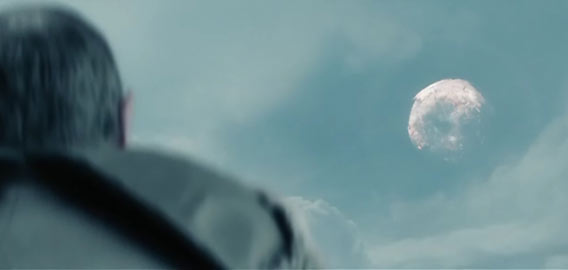
Photo by Paramount Pictures Corp. All rights reserved.
The 2009 Star Trek reboot movie was a lot of fun (I reviewed it when it came out), and introduced quite a bit of new tech and science into the show. I know, I know: The “red matter” irked me too, but inside the story I figure it’s just a plot device, and I’m willing (grudgingly) to let it go.
Actually, the misuse of science that got me was when we see (“our”) Spock standing on the planet Delta Vega, and he watches the planet Vulcan collapse into a black hole. It seems innocuous enough… but to an astronomer that was a cardinal sin.
The problem is distance. Unless Delta Vega were a moon of Vulcan (and in the original series Spock says his planet has no moon), the planet would be way, way too far away to see as anything but a point of light in the sky. And that’s if it’s in the same star system; from another star, even Vulcan’s star might be too far away to see (also, Delta Vega is established in the original series as a remote planet, the location of a dilithium mining station).
That’s the sort of science abuse that, despite my better nature, pulls me right out of the movie. I’m sure most people wouldn’t have given it a second thought, but to an astronomer it's like being served a bowl of cold, dead gagh.
The Adventure Continues
I could go on and on. Plasma fires, exploding stars sterilizing galaxies, polarizing hulls, inverting the decyon field, the transporter turning people into children, humans devolving into spiders and lemurs and fish. It’s a target-rich environment.
But, there’s a lot Trek gets right as well. It predicted ion drives, floppy disks, and flip-open phones, for example, and there’s work right now to make a medical tricorder.
But my favorite science prediction it made was a tacit one: The galaxy is filled with planets. That was completely unknown in the 1960s; heck, even by the time TNG aired only a handful of planets had been found orbiting other stars. Now we know that a large fraction of stars have planets, and in fact planets may outnumber stars in the galaxy!
That’s a pretty cool thing to get right. I prefer a galaxy filled with planets, and possibly life, to one that’s empty and void. Star Trek inspired me when I was a kid, feeding my craving for science and aliens; I became an astronomer in no small part due to the boost I got from shows like it. Science fiction like Trek is filled with tales of high adventure, hopping from one planet to the next, seeking out new life and new civilizations, people working together peacefully for a common purpose. That is a profoundly hopeful future, one where we make it off this planet and into the depths of space. Maybe in real life we won’t meet aliens like us, but to even get the chance to try is a goal worth pursuing.
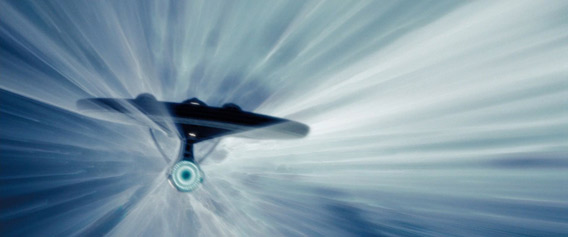
Photo by Paramount Pictures Corp. All rights reserved.
And that’s a big reason, despite my snarky joking about it here, the science errors strewn throughout Trek don’t really bug me. There’s a much bigger picture, a grander goal, to be had.
As Kirk himself said, all we need is that sense of enterprise.

